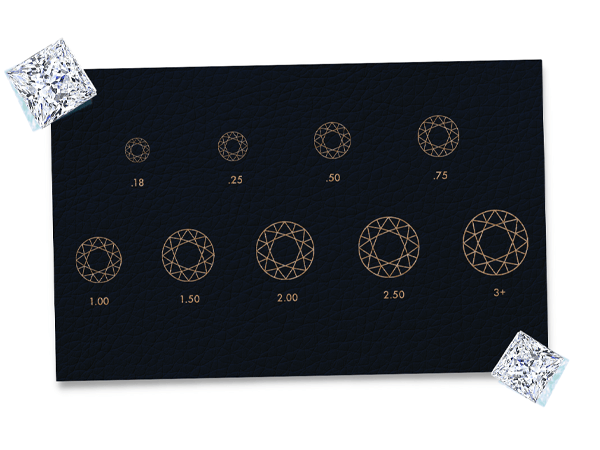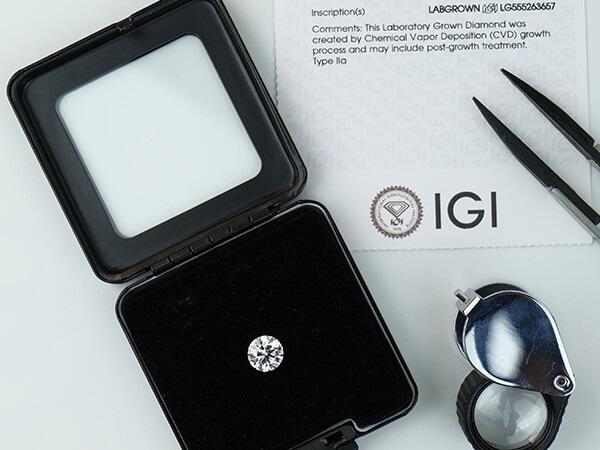4C's of diamond
Diamond jewelry symbolizes celebration, honoring moments, and commemorating love and commitment. At Dev Jewels, we strive to maintain our promise of sustainability and finest quality by offering lab-created diamond options for you to choose from.
Understanding the unique characteristics of a diamond is crucial before making a selection. The 4C's universal method of checking diamond quality, which assesses a diamond's cut, color, clarity, and carat weight, determines its value and visual appeal. By delving deeper into these 4C's, you can better understand how they impact a diamond's overall quality. Explore further to learn more about the significance of these grading criteria.
Diamond Cut
Be careful when purchasing not to mistake cut for shape. The stone's form determines whether it is a cushion cut diamond, round cut diamond, princess cut diamond, or another type of cut. On the other hand, a diamond's cut measures the artisan's ability to plan, map, and manually cut each diamond's facets. One of the most crucial of the 4C's, a diamond's cut is the most crucial element in defining its worth in terms of fire, brightness, and scintillation.
In essence, a diamond's cut affects how well light enters the stone, is diffracted inside, and reflected through the diamond's top. The higher a diamond's proportions, symmetry, and polish are, the better it will perform in terms of fire, brightness, and scintillation. Every lab-created diamond from Dev Jewels is given an ideal defined cut rating, ensuring that you will get one of the best stones available.
Diamond Color
Diamond Clarity
The frequency of inherent flaws or inclusions in a diamond is graded by its clarity. A diamond rated SI2 or higher typically appears "eye clean," meaning flaws cannot be seen without a 10x jeweler's loupe. The unaided eye can easily see eye-evident flaws and are typically present in diamonds graded below SI2. Diamond clarity traits are typically split into two groups for grading.
Natural flaws called inclusions exist within the diamond itself. They were created during the diamond's formation under extreme heat and pressure.
Blemishes are surface flaws that develop during the diamond's cutting and polishing processes. The inclusion’s quantity, size, nature, and location—such as the diamond's tiny white points, dark spots, or feathery cracks—determine the stone's clarity.
We at Dev Jewels put immense effort into examining a diamond’s clarity characteristic to be always SI2 or better, making it a diamond which you can wear with great pride.
Diamond Carat Weight
Unfortunately, this means that for many of us, we cannot buy a larger stone that could better capture the depth of our love for the person we care about.
We take great satisfaction in only providing stunning Lab Created Diamonds at prices substantially cheaper than those of mined diamonds, enabling you to keep within your budget while still receiving a significant "wow" from your diamond ring or exclusive Fancy diamond shapes.
Why is it important to consider the 4C'S of diamonds?
To harmonize the grading of diamonds around the world, the GIA International Diamond Grading System was created. As a result, buyers may easily comprehend what they are purchasing by comparing the four attributes of the diamond—cut, color, Diamond clarity, and carat—to the GIA diamond grading chart.
Since lab-grown diamonds are the same as natural diamonds, they are rated using the same standards as mined diamonds under the GIA and IGI natural diamond grading system.
Physically, visually, and chemically, lab-grown diamonds are the same as mined diamonds. This indicates that reputable lab-grown diamonds are also formally rated by independent
gemological groups utilizing the 4C's. The 4C's of diamonds of lab-grown diamonds can range in quality from bad to exceptional, much like natural diamonds.
Shapes and C's
For fancy shapes, the 4C's of diamonds can react a little differently. In fancy-shape diamonds, C's like clarity and carat might be more forgiving. As a result, these diamonds might appear more prominent on larger tables, maximizing a lesser-carat weight. In more sophisticated cuts, inclusions that are a concern for round diamonds may be concealed or eliminated. The 4C's of fancy-shaped diamonds are likewise distinctive in clarity, with each stone's unique faceting.
Colorful Diamonds
While one of the 4C's for determining how colorless a stone is in diamond color, there are some stones where colorful colors are deliberate and even appreciated. Diamonds can be purchased in various colors, including yellow, pink, green, blue, and brown. For fancy color diamonds, color is determined by the stone's hue, intensity, overtones, and saturation rather than by how colorless it is. However, the 3C's of cut, clarity, and carat weight are still crucial when buying colored diamonds.
Why dev jewels?
The interactions between the distinct 4C's of a diamond can change how a stone looks overall.
Our loose diamonds' 4C's are assessed using a uniform grading system. These labs have strict grading and certification standards to evaluate diamond quality.







